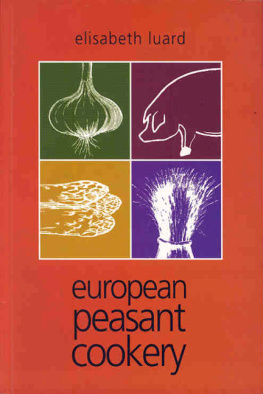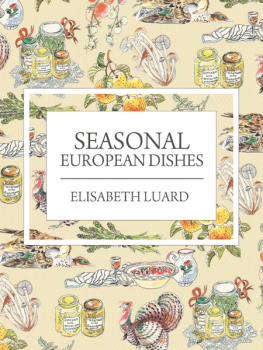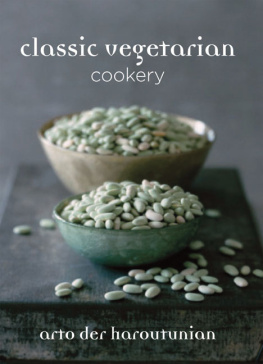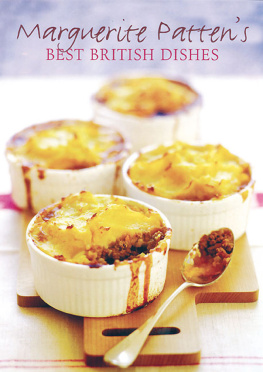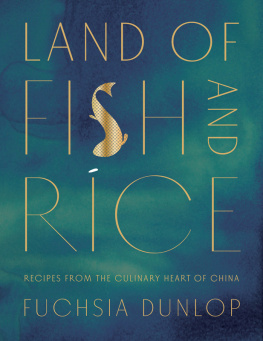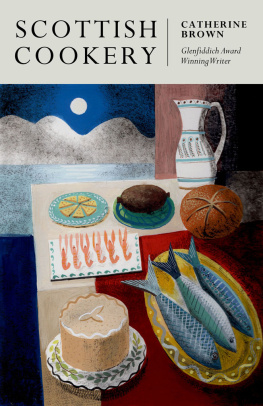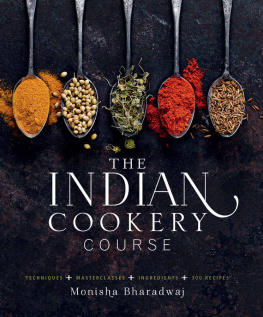ACKNOWLEDGEMENTS
Over the years many people from many countries have helped me in many ways with the preparation of this book, notably those who appear in person in the text. In addition to them I owe particular gratitude for patient assistance in cultural and culinary matters to Betty Molesworth Allen, Maurice Panton dAmecourt, Bernard Aug, Elisabeth and Odbjorn Andreassen,Viviker and Richard Bernstrom, Tomas Bianchi, Mrs Vasili Frunzete, Alfred Grizel, Christian Hesketh, Vane Ivanovic, Frau Klein, Mitte Lhoest, Cecilia McEwen, Maureen McGlashan, Kiki Munchi, Ilhan and Ruya Nebioglu, May Pocock, Dr Astri Riddervold, Monica Rawlins, Erzbet Schmidl, Iolanda Tsalas, and Jacqueline Weir. Above all,my thanks to Priscilla White, who valiantly tested the recipes in my kitchen; to my inspiring and hardworking editor, Kate Parkin; and to my beloved companion at table, Nicholas. For new work included in this edition, I owe particular thanks to Dun Gifford of Oldways in Boston, Mass. And finally to the editor and publisher of this new revised edition, the estimable Anne Dolamore.
For my children Caspar, Francesca, Poppy and Honey, without whom there would have been no book.
This new revised edition published in 2004 by
Grub Street
4 Rainham Close
London
SW11 6SS
Email: food@grubstreet.co.uk
www.grubstreet.co.uk
Text copyright Elisabeth Luard 1986, 2004
Copyright this edition Grub Street 2004
Cover design by AB3 Design
Typeset by Pearl Graphics, Hemel Hempstead
First published in Great Britain by Bantam Press, 1986
British Library Cataloguing in Publication Data
Luard, Elisabeth
European peasant cookery. Rev. ed.
1. Cookery, European
I. Title II. Luard, Elisabeth. European peasant cookery
641.5'94
ISBN 1 904010 50 4
eISBN 978-1-908117-92-2
All rights reserved. No part of this book may be reproduced or transmitted in any form or by any means, electronic or mechanical, including photocopying, recording or any information storage and retrieval system, without permission in writing from the publisher.
Printed and bound in Great Britain by Biddles Ltd, Kings Lynn
INTRODUCTION
This book had its genesis in a remote valley in Andalucia in the late 1960s, when the world was a different place. The Iron Curtain obscured the lives of much of Eastern Europe; Western Europe was still recovering from the effects of two world wars and the people of the Mediterranean littoral were still locked in what some might call a medieval way of life.
Where wemyself and writer-husband Nicholas, our growing family of three (soon to be four) small childrenchose to make our home, Spains ferocious civil war had left its mark on the land and the people. Franco, the old dictator, was still in power, limiting what the people might decide for themselves. In that part of southern Spain, modern life had not made many inroads on the self-sufficient community of subsistence farmers among whom we settled. Brought up a diplomats stepdaughter in Spanish-speaking lands and confident that the Latin attitude to children would allow us to live more merrily than among the Anglo-Saxons, I had no doubts about the rightness of the decision. Where we lived as a family, I considered, was essentially my decision, leaving Nicholas, a regular but short-term visitor in the early years, until he took the decision that he could afford to earn the family living as a full-time writer, supplemented by my work as a botanical and wildlife artist. Nothing is ever so simple, naturallybut as an explanation, itll have to do.
Meanwhile, the market stalls in the port of Algeciras among which, as a young wife and mother, I found myself and my basket one bright June morning in 1965 had very little in common with the shelves of the city supermarkets where I had been accustomed to shop. I was bewilderedbut intrigued. A childhood spent in several distant parts of the world with my parents, foreign-posted diplomats, had given me an early appetite for street-corner food. This youthful enthusiasm had also left me with an unshakeable optimism that I could eat, and usually appreciate, anything that was palatable to any other human.
Algeciras market daily delivered the harvest of the countryside to the housewives of the town. Nothing was ever available out of season, and only the spice lady sold imported goodsthe eastern flavourings for which the people of Andalucia had acquired an appetite during seven centuries of Moorish ascendancynot the least of the legacy of the Muslim caliphs.
Breadlozenge-shaped country loaves with a deep caramel-coloured crustwas sold from the back of a little van, the product of one of the many rural household bakeries which still threshed and ground their own wheat, raised the dough with leaven from previous bakings and baked in an oven fuelled with olive prunings and clippings from their own vineyards. There was cheese too, rounds no bigger than could be made with the days milking of a single goat, turned with rennet made from the curd to be found in the stomach of a new-born kida sacrifice which could only be contemplated by those rich enough to maintain a flock of goats, and which in a poorer household would be replaced with fig-tree sap, or an infusion of wild artichoke heads.
The vegetable stalls which formed the outer ring were piled with unfamiliar greenery: a heap of prickly thistle-rosettes tagarnina waving tarantula-like green extremities; bundles of fresh garlic, like ice-white onions; smiling pink segments of watermelon; purple-tipped artichokes tied in rosebud bunches. Between them little encampments of gypsy children presided over sacks of tiny snails with translucent bodies and inquiring pin-stalk eyes, baskets of wild mushrooms and bundles of slender wild asparagus bound with esparto grass. The fish vendors, raised above their customers on a line of white tiled stalls dripping seawater, were bellowing out their wares: octopus, squid, cuttlefish; monkfish, sea bream, bass, anchovies and sardines.
The poultry market was livelier still. There were bunches of chickens squawking on the ends of brawny arms, a blue-eyed goose, and a few mournful turkeys gobbling in one cornerno Andaluz housewife would have trusted a dead barnyard bird as far as she could chase it. The spice lady must have had fifty open sacks around her: almonds, six kinds of tea, bay leaves, dried garlic and paprika, cloves and cinnamon bark, thyme, rosemary, marjoram, coriander, poppy-seeds, liquorice twigs, pumpkin seeds, dozens more. Often she would be asked to make up a flavouring mix: a paper twist of the herbs to spice four kilos of snails, to prepare a side of pork in paprika lard, to provide the aromatics for ten kilos of olives. Later I learned to rely on her expertise myself.
Maria, my neighbour up the valley where I and my growing family settled, was my mentor in those first years. Asi se hace, this is how its done, she would patiently explain as I struggled with the ink sacs in the cuttlefish, or attempted to cook the chickpeas without soaking them first. Very often she would come by with gifts of food for my childrenhoney from her uncles hives, the first figs, wrapped in one of their own leaves, from the tree in her fathers garden, oil biscuits which she had made after bread-baking day.
My family and I saw the seasons round in the valley. The children went to the local school, where they learned along with their letters how to trap and skin rabbits, how to stake pastures to hold the forests hogs, and how to mend a hand-drawn threshing sled made to a design unchanged since the Iron Age. With Marias advice and under her tutelage we acquired a donkey, a kitchen garden, and a household pigthe last, I stipulated, only if Maria helped me at its final hour. The pig thrived mightily on the scraps from my kitchen. Finally on a late October day deemed suitable, the moon being in the right quarter and the pig having been fattened to the correct weight on acorns from the surrounding cork oaks, Marias husband and brother-in-law arrived at sunrise to prepare for the dreaded event. Soon afterwards Maria, her cousins, and her mother, appeared to help with the kitchen labour. The children were packed off to school early, and all day we worked salting hams, seasoning sausages, stuffing black puddings, spicing chorizos. That evening, as she prepared the traditional celebration meal of chicharros pork skin fried crisp, kidneys in sherry and garlic-fried liver which follows a country matanza, Maria finally put the question which made me embark on this book.

